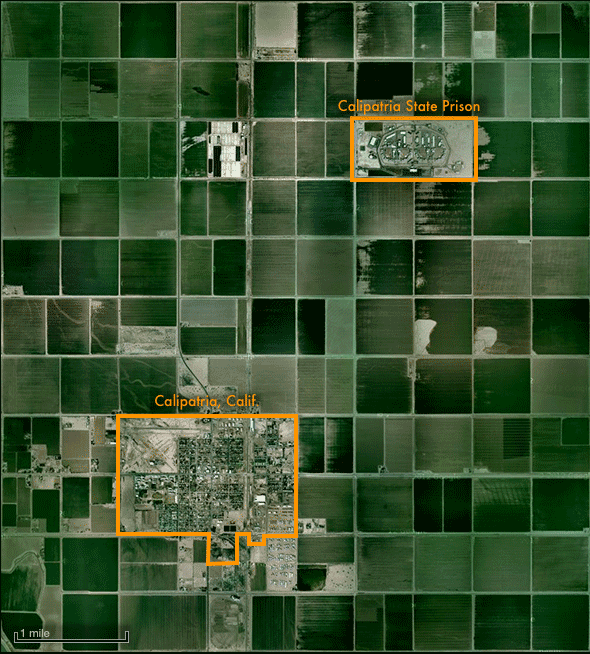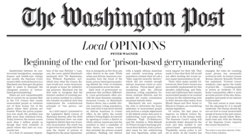Is a piece of land containing a prison on a dusty piece of highway really an urban area? The Census Bureau doesn’t think so. Anymore.
by Drew Kukorowski,
August 23, 2012
About three miles north of Calipatria, California, the state of California operates the Calipatria State Prison. Based upon the 2000 census, the United States Census Bureau classified “Calipatria North, California” as an “Urban Cluster” with a population of 3,176. But is a piece of land containing a prison on a dusty piece of highway really an urban area? I don’t think so, and the Census Bureau doesn’t think so either. Anymore.

Recently, the Census Bureau released the list of “Urbanized Areas” and “Urban Clusters” that were classified as urban based on the 2010 census data. This new list incorporated a quirky but important change that the Census Bureau finalized in 2011. Specifically, the Census Bureau no longer labels an area “urban” if the majority of the population counted there is institutionalized in a prison, mental hospital or similar group quarters facility.
I discovered this quirk – and the pending change – during my Alternative Spring Break internship at the Prison Policy Initiative last year. I was investigating an Arkansas highway funding formula that, in part, gave extra funding to counties that had a large portion of their population classified as “rural.” This formula made a lot of sense, as rural populations are more spread out, so there would presumably be more roads per capita to maintain. Unfortunately for rural Arkansas counties, classifying prisons as “urban” made the counties that hosted prisons seem more urban than they actually were.
While most of our work at Prison Policy Initiative addresses prison-based gerrymandering, this urban classification problem is just one of many examples we’ve come across of how the Census Bureau’s policy of counting incarcerated persons at the location of prisons can distort governmental decision-making that relies on accurate portrayals of communities.
To the Census Bureau’s credit, it changed the way it classifies areas as “Urban Clusters” to avoid this problem. In reviewing the 2000 data, the Census Bureau acknowledged that twenty-four “Urban Clusters” from the 2000 census data were comprised “entirely or predominantly” of residents in institutional group quarters (cite: 75 FR 52178-79). Realizing that such areas “lack most of the residential, commercial, and infrastructure characteristics typically associated with urban territory,” the Census Bureau proposed that an Urban Cluster meet two requirements: that the area contain at least 2,500 people and that at least 1,500 of those persons be outside of institutional group quarters. In 2011, the Census Bureau finalized this proposal, and reiterated that persons counted in institutional group quarters lack the residential and commercial characteristics associated with the surrounding community (cite: 76 FR 53036). In other words, it’s a mistake to classify big prisons in the same way as urban communities.
While this an admittedly minor rule change, the Census Bureau’s rationale for the change is noteworthy. The Census Bureau acknowledged that institutional group quarters populations, many of which are incarcerated, lack sufficient connections to the surrounding community to justify their unrestricted use for census data purposes. Moreover, the Census Bureau implemented a reasonable correction to this particular problem caused by counting incarcerated persons as residents of the prisons in which they are incarcerated.
We should take heart from the fact that the Census Bureau is slowly but surely acknowledging and ameliorating the distorting effects caused by its policy of counting incarcerated persons at the location of prisons, rather than at their home addresses. The next logical step would be for the Census Bureau to review how it counts prison populations for data used in redistricting. It’s in the redistricting context that the Census Bureau’s prison miscount has the most severe implications.
Under Dr. Groves, the 2010 Census was a huge success for the Census Bureau. The President should appoint the next director as soon as possible to make the 2020 Census as efficient and high quality as possible.
by Peter Wagner,
August 22, 2012

Dr. Robert Groves (left) at a February 2010 Congressional hearing, “2010 Census: Enumerating People Living in Group Quarters.”
Source: Our Time Press
On Friday, the Census Bureau lost its director when Robert Groves stepped down to be Provost of Georgetown University.
Director Groves was appointed to run the Census Bureau in 2009, with the 2010 Census rapidly approaching. Director Groves quickly put his stamp on the agency, working to cut costs and increase quality, while also working a tireless national travel schedule to promote participation in the Census. The 2010 Census was widely considered a success, and Dr. Groves deserves much of the credit.
Here at the Prison Policy Initiative, we wanted to highlight one of the less talked-about good news stories about the Census Bureau under Dr. Groves’s leadership. For the first time, the Census Bureau agreed to identify which census blocks contained group quarters, such as correctional facilities, early enough that state and local redistricting bodies can choose to use this data to draw fair districts.
As Dr. Groves explained on his blog: “This decade we are releasing early counts of prisoners (and counts of other group quarters), so that states can leave the prisoners counted where the prisons are, delete them from the redistricting formulas, or assign them to some other locale.”
Of course, we here at the Prison Policy Initiative have long urged the Census Bureau to count incarcerated people as residents of their home addresses; but this change was a big one. It didn’t require state or local governments to do anything differently, but it did give those government bodies more choices.
Director Groves further explained this change in his testimony to Congress:
The Census Bureau recently decided to provide an early release of 2010 Census counts of residents of group quarters in May 2011.
We will supply the block-level counts as defined by Public Law No. 94-171, used in redistricting activities in the states by the end March, 2011. We learned in discussions over the past few months with external stakeholders that providing a related tabulation might be useful to them. We also learned that the tabulation would be helpful to our partners in local and state governments, and in our own Count Question Resolution Program, which looks for anomalies in the census counts at low levels of geography.
To serve these needs the Census Bureau is preparing to release a planned table from our Summary File 1 product plan, the P-41 table, a few months earlier than the release of the entire Summary File 1 product, which is scheduled for release June through August 2011. This single table is not a special tabulation or a preliminary table—but an early release of a planned table to facilitate potential uses to a host of data users. […]
What this table provides is a tool for those public officials charged with the responsibility of redistricting their state legislative boundaries the opportunity to assess the significance of group quarters populations in their plans. This table does not remove prisoner populations from their respective census tabulation blocks. This table will not remove group quarters populations from the 2010 census totals. There should be no impact on the distribution of federal, state or local funds based upon the early release of this table. This release is consistent with providing the states with the tools they need to conduct their legislative redistricting.
I would like to stress that the Census Bureau does not participate in any redistricting activities. Our job is a completely nonpartisan, objective enumeration of the population. Simply put, the Census Bureau collects individual information and reports aggregates based on it. Fittingly, the Founding Fathers left it to the federal, state, and local governments to use the information for their political purposes. In that vein, the Census Bureau endeavors to compile the group quarters information in the Summary File for its key data users at the state and local level. How those levels of governments choose to use the data is squarely within their realm of authority.
This effort by the Census Bureau was a big success. As redistricting experts discussed two weeks ago in Chicago at the National Conference of State Legislatures conference, the early release of the prison count data was essential to the implementation of Maryland and New York‘s laws that counted incarcerated people at home. And at that meeting, I shared that I knew of at least 132 local governments that removed the prison populations prior to redistricting.
Georgetown’s gain is unfortunately the Bureau’s loss. I hope the President will appoint a replacement as soon as possible. The wellbeing of our nation depends on accurate data, and under Dr. Groves, the Census Bureau had a very huge success in the 2010 Census and already has begun planning for the next Census. The next Census might be more than 7 years away, but the Bureau is already hard at work. The best way to have the highest quality Census at the lowest possible cost is to ensure that the Bureau can benefit from strong permanent leadership for the entire decade.
Statewide legislation addressing prison-based gerrymandering would eliminate inconsistency and help to ensure that all Louisiana citizens have equal access to their local governments.
by Hillary Fenton,
August 22, 2012
The state of Louisiana has the highest incarceration rate of anywhere in the world. This creates a host of issues for the state, including the distortion of democracy caused by the inclusion of large prisons during redistricting. This problem is called prison-based gerrymandering. Though some parishes in Louisiana have implemented their own solutions to prison-based gerrymandering in their parish local government districts, called “police jury districts,” other parishes continue to include incarcerated populations during redistricting. Given the inconsistency in parish democracy, a statewide solution to prison-based gerrymandering may be necessary.
Among the parishes with the proportionally largest prison populations, about half excluded their prison populations during redistricting following the 2010 Census, preventing the vote distortion that would have been caused by including the incarcerated populations. For the most part, the higher a parish’s prison population relative to its total population, the more likely they were to exclude the prison population.
Two parishes excluded their incarcerated populations in order to prevent an impossible electoral situation. Claiborne Parish, on the northern border of the state, would have had an entire police jury district comprised of incarcerated populations if they had included the prison populations during redistricting.
West Feliciana Parish also faced the same problem. The parish is home to the Louisiana State Penitentiary, commonly known as Angola, which contains 5,147 people according to the 2010 Census. West Feliciana as a whole has a reported population of 15,625 and seven police jury districts. This means that if the prison population had been included during redistricting, the incarcerated population would have filled two entire police jury districts. For those who are working to end prison-based gerrymandering in Louisiana, it might seem strange to look for support from the parish that contains Angola; however, that parish is the prime in-state example of why recognizing and preventing prison-based gerrymandering is so important. As both Claiborne and West Feliciana parishes know well, when prison-based gerrymandering reaches such dramatic levels, the problem becomes impossible to ignore.
Though parishes were more likely to exclude prison populations when those populations made up a high percentage of the parish population, a few parishes went against this trend by including large incarcerated populations during redistricting, creating severe distortions in their local democracy.
Allen Parish has the most acute prison-based gerrymandering vote distortion of any parish in the state. Two of its seven districts contain large corrections facilities: 66% of District 1 is incarcerated in FCI and FDC Oakdale, and 39% of District 6 is incarcerated in the state-run Allen Correctional Center. This means that the non-incarcerated populations of these districts are substantially smaller than the populations of the districts without prisons. Because these smaller voting populations in the prison districts each elect a whole representative for themselves, each voter in the prison districts has more say in parish government than those in other districts. In District 1 for example, one voter in that district has the same political power as three voters in other districts.
Inconsistency in addressing prison-based gerrymandering is not only a problem among Louisiana parishes, but also within parishes themselves. Although FCI and FDC Oakdale are included in Allen Parish police jury districts, ironically the same prison populations are excluded by a city in Allen Parish: the City of Oakdale. Otherwise, Oakdale would have had one district that was entirely people incarcerated at the federal prison who are unable to vote.
Statewide legislation would eliminate these inconsistent approaches from parish to parish and would, most importantly, would help to ensure that all Louisiana citizens have equal access to their local governments.
Making the videos was a great opportunity for us to explain how the Prison Policy Initiative came to be and present our vision for the future of the criminal justice and democracy reform movements.
by Peter Wagner,
August 17, 2012
The Laura and John Arnold Foundation has given the Prison Policy Initiative a great platform to tell funders about what we do. On Tuesday, the foundation launched the Giving Library, which features video presentations by 250 non-profits, including the Prison Policy Initiative.
On the site, each organization is featured in a short introductory video, and a “virtual meeting” allows donors to hear the answers to 10 questions about the organization’s history, success, challenges, myths and future plans. I filmed our video in February, and the Giving Library website went live earlier this week.
The Laura and John Arnold Foundation produced the Giving Library to make it easier for philanthropists examine a large number of potential recipients. Meredith Johnson, director of Communications for the foundation, explained in a press release that going online to meet potential new grantees streamlines philanthropy: “What would have taken months or even years of meetings and travel can now be done in a matter of days, from anywhere.”
We were particularly thrilled to participate in the online Giving Library because, while our work is national in scope and impact, we are located in a part of the country where networking with potential donors often requires expensive and time consuming travel.
Making the videos was a great opportunity for us to step back and explain how the Prison Policy Initiative came to be and present our vision for the future of the criminal justice and democracy reform movements. The Laura and John Arnold Foundation has made a great tool that will bring philanthropy and non-profits together, and I’m honored that they choose the Prison Policy Initiative to participate.
After the passage of the No Representation Without Population Act, the county that had no functional majority minority Commission districts draws two.
by Leah Sakala,
August 16, 2012

The Somerset Herald reports that a county in Maryland that had never elected an African American to county office may soon elect two, thanks to the Maryland law that ended prison-based gerrymandering. Although Somerset County Maryland contains a sizable African-American population, first slavery, then Jim Crow, and then prison-based gerrymandering prevented the African-American community from being able to elect a candidate of its choice for hundreds of years.
Activists from Somerset County played a central role in passing Maryland’s first-in-the-nation law requiring that incarcerated people be counted at their home addresses for state and local redistricting purposes. This law capped an effort to secure fair representation in Somerset County that spanned several decades. In the 1980s, in order to settle a Voting Rights Act lawsuit brought by local activists, the county agreed to create a majority minority district to allow the African-American community to elect a candidate of its choice.
But the effort was foiled because the district was drawn based on U.S. Census data that counted the people incarcerated in the Eastern Correctional Institution as residents of the county. When county officials redistricted after the 1990 Census, they drew a district that appeared to be majority African American. But because a large portion of the minority population that was counted in the new district was made up of incarcerated people who were not allowed to vote, there weren’t enough actual African-American voters in the district to elect the candidate of their choice. As Deborah Jeon from the Maryland ACLU explained,
“I wasn’t here in ’87 when the prison opened, but I was here in 1990 and it was on my radar screen that something in Somerset was amiss. It didn’t seem to be working fairly. We began to focus on the prison and the effect of the prison on the election.”
The handful of voters who lived near the prison had more than twice the representation on the county commission that their numbers warranted, and including the prison in that district made it impossible for African Americans anywhere in the county to elect a candidate of their choice. In terms advancing minority voting power, the county lived up to its official motto: “Semper Eadem” or “Always the Same.”
But in 2009, a coalition of local activists worked together with the Somerset County chapter of the NAACP, the Maryland ACLU, and the Legislative Black Caucus to document the problem and find a remedy. Their efforts resulted in a state-wide solution to the problem of prison-based gerrymandering that ensured that the African-American community of Somerset has the opportunity to be fairly represented in county affairs.
The No Representation Without Population Act of 2010 ensures that everyone has the same access to government regardless of whether or not they live next to a large prison, and the law ended the practice of giving extra representation to a state legislative district in western Maryland that was 18% incarcerated. The law also ensures that no district in the state is able to masquerade as a functional majority-minority district solely because it contains a large prison population.
With the endorsement of the U.S. Supreme Court in June, the No Representation Without Population Act is firmly established as one of the major civil rights victories of the decade. And when Somerset County holds the next County Commissioner election in 2014, Somerset residents will be able to choose a Board of Commissioners that faithfully reflects the needs and interests of the county’s actual population.
The combination of a falling population and swelling prison made Jackson County's prison-based gerrymandering problem even worse.
by Hillary Fenton,
August 10, 2012
Like many counties across the country, Jackson County in northeastern Arkansas relied on the 2010 Census to determine its population for redistricting purposes. Unfortunately, because the Census Bureau counts those in prison where they are incarcerated rather than where they are from, Jackson County’s use of unadjusted census data has resulted in distortion of democracy among its Justice of the Peace districts, amplified even more by a shrinking county population and a growing prison population.
This distortion is a result of prison-based gerrymandering, or the counting of nonvoting prison populations as part of the total population during redistricting. Because the widely-used U.S. Census continues to count those in prison at their place of incarceration, prison-based gerrymandering is a problem nationwide. Even though Arkansas state law declares that incarceration does not change a person’s legal domicile, Jackson County ended up including its prison population in its redistricting data because they relied on unadjusted census counts.
Jackson County contains two large state prisons, the Grimes and McPherson Units. Grimes is a medium security men’s facility, and McPherson is a women’s prison and includes the women’s death row. The two facilities were opened in 1998 by Wackenhut Corrections Corporation, and were later transferred to the state and expanded. According to the 2010 Census, the total incarcerated population of both facilities is 1,777.
After both the 2000 and 2010 censuses, Jackson County drew the 5th Justice of the Peace district to encompass the Grimes and McPherson Units, including the prison populations in the total district population. After the redistricting based on the 2000 Census, the populations of the Grimes and McPherson Units made up nearly two thirds (64%) of District 5’s total population. After redistricting following the 2010 Census, due to a 2.4% drop in the county’s overall population and a rise in the prison population, the percentage of the district population made up by the incarcerated population rocketed to 87%.
Prison-based gerrymandering distorts democracy because including prison populations during redistricting inflates the political power of those voting in a prison district. Each of Jackson County’s Justice of the Peace districts should, based on the Census, have around 2000 people. According to the census, each district does have around that number; however, because of the inclusion of the Grimes and McPherson Units in District 5’s population, only 278 people out of the total population of 2055 are eligible to vote. This means that, even though District 5 has a voting population a fraction of a size of other districts, those 278 people are still able to elect a whole representative for themselves just like those in districts with 2000 voters. The inclusion of the prisons in the total population of District 5 artificially inflates the political power of the voters there because it gives 1 voter in District 5 the same say in county government as 7 voters in other districts. Redistricting is supposed to ensure that citizens are equally represented in government, but in places like Jackson County, the inclusion of prison populations during redistricting gives disproportionate influence to those in prison districts. In Arkansas, this problem is not limited to Jackson County; several other counties in the state also drew Justice of the Peace districts that were distorted by prison populations in the last redistricting cycle.
Fortunately, several states require that counties and municipalities exclude incarcerated populations during redistricting, and more than 100 county and municipal governments across the country choose to do this on their own. Four of those counties are in Arkansas: Lee, Lincoln, St. Francis, and Hot Spring counties all chose to modify 2010 Census data and leave out their prison populations during 2010 redistricting. Though it is encouraging that some states and many local governments have acted to prevent prison-based gerrymandering, ideally the Census Bureau should count incarcerate people at their home addresses in the first place, a solution that would eradicate the problem of prison-based gerrymandering nationwide.
Western Massachusetts newspaper reports that state lawmakers are looking for ways to end prison-based gerrymandering.
by Peter Wagner,
July 27, 2012
 Massachusetts is headed in the right direction towards ending prison-based gerrymandering, reports a new feature in the Valley Advocate.
Massachusetts is headed in the right direction towards ending prison-based gerrymandering, reports a new feature in the Valley Advocate.
“The way the Census Bureau counts people in prison creates significant problems for democracy and for our nation’s future,” in the words of the Prison Policy Initiative, a think tank based in Easthampton. This “prison-based gerrymandering,” PPI says, “leads to a dramatic distortion of representation at local and state levels, and creates an inaccurate picture of community populations for research and planning purposes.”
PPI and other groups have been pushing to change that system for years, and it appears they now have some powerful allies on their side—among them, state Sen. Stan Rosenberg (D-Amherst), the Senate’s president pro tempore and co-chair of the Legislature’s Joint Committee on Redistricting. “The whole point of redistricting and the whole point of our system is, we all have equal representation,” Rosenberg told the Advocate. By counting incarcerated people who, by law, are not able to vote in the districts where they’re locked up, he explains, “you are creating disproportionate voting power in those districts among those people who are eligible to vote.” In light of that inequity, Rosenberg said, it just makes sense for the census to change the way it counts prisoners.
Read the rest of the great article on newsstands throughout Western Massachusetts this week or on the Valley Advocate’s website: Prisoners Count: Lawmakers look at fixing Massachusetts’ “representation without population” problem.
The Norwich Bulletin urges the legislature to pass bill to count incarcerated people at home for the next redistricting cycle.
by Leah Sakala,
July 24, 2012

Lately the Connecticut press has been buzzing with coverage of prison-based gerrymandering. Following the U.S. Supreme Court’s affirmance of Maryland’s historic law ending prison-based gerrymandering, states like Connecticut are showing a renewed commitment to passing legislation to count incarcerated people at home for redistricting purposes in the next decade.
Most recently, the Norwich Bulletin printed an editorial, “Our View: Prisons Skew Census Numbers,” calling on the Connecticut Legislature to take action. The editorial explains why the question of where incarcerated people are counted is a big deal for Connecticut’s democracy:
Those skewed population figures also impact legislative boundaries that are re-apportioned every 10 years based on the U.S. Census. These individuals are ineligible to vote because they are convicted felons serving prison sentences, yet they are counted as residents in calculating and redrawing political boundaries.
Maryland adopted a law that counts prisoners as residents of communities of their last legal address, not the community where they are incarcerated — a law the U.S. Supreme Court upheld as constitutional earlier this month.
Connecticut has twice tried to adopt a similar measure, but with no success. We hope that lawmakers will try again next year.
This editorial also presented a great opportunity for our Executive Director to clarify that the legislation to count incarcerated people at their home address for redistricting purposes does not impact funding distribution in any way. It’s a common misunderstanding, but state or federal funding formulas are never based on state redistricting data.
And if you missed it, be sure to check out the recent Hardfort Courant editorial as well.
In the next legislative session Rep. La Shawn K. Ford will reintroduce legislation to count incarcerated people at home for redistricting purposes.
by Leah Sakala,
July 24, 2012

Representative La Shawn K. Ford
The days of prison-based gerrymandering may be numbered in Illinois.
This morning, Illinois State Representative La Shawn K. Ford announced that the U.S. Supreme Court’s decision to uphold Maryland’s law ending prison-based gerrymandering reaffirms his proposed legislation to count incarcerated people at home for state and local redistricting purposes in Illinois:
“My bill, and the one passed by Maryland, represent state-based solutions to a long- standing problem in the federal Census. The federal census counts people in prison as residents of the prison location, even though they can’t vote and remain residents of their homes for all other legal purposes,” said Rep. La Shawn K. Ford (D-Chicago).
The Illinois bill introduced by Rep. Ford, HB 94 made it all the way to a floor vote last year. Rep. Ford expects to re-introduce legislation in the next session of the Illinois General Assembly. New York, Delaware and California have already passed similar laws.
Rep. Ford’s bill would adjust redistricting data to count incarcerated people where they live. The bill applies to state, county, and municipal redistricting data, ensuring that prison populations are not used to skew political power in state or local government. Such changes to redistricting data have no affect on the distribution of federal funds.
“Representative Ford has been advocating for an end to prison-based gerrymandering long before the problem was on the national radar. The Supreme Court has given a green light to Rep. Ford’s bill to end prison-based gerrymandering in Illinois,” said Peter Wagner, Executive Director of the Prison Policy Initiative and the nation’s leading expert on how the Census Bureau’s practice of counting incarcerated people as residents of the prison locations harms the democratic process.
Ending prison-based gerrymandering in Illinois would be beneficial to every resident who does not live next to a large prison, and Rep. Ford’s legislation has the support of a strong local coalition.
With all the pieces in place, and with the support of the landmark Supreme Court decision, prospects look good for Illinois to join the growing list of states that have put an end to the practice of prison-based gerrymandering.
"An End to 'Prison-Based Gerrymandering'" explains what our victory in the Supreme Court means for the national movement to end this repugnant practice.
by Peter Wagner,
July 14, 2012
 Tomorrow, the Washington Post will run my op-ed Beginning of the end for ‘prison-based gerrymandering’. The piece reviews last month’s Supreme Court ruling that summarily affirmed Maryland’s “No Representation Without Population Act” that counts incarcerated people as residents of their home addresses for redistricting purposes. This decision gives the green light to states to eliminate the repugnant practice of prison-based gerrymandering.
Tomorrow, the Washington Post will run my op-ed Beginning of the end for ‘prison-based gerrymandering’. The piece reviews last month’s Supreme Court ruling that summarily affirmed Maryland’s “No Representation Without Population Act” that counts incarcerated people as residents of their home addresses for redistricting purposes. This decision gives the green light to states to eliminate the repugnant practice of prison-based gerrymandering.
The op-ed is already online.




 Tomorrow, the Washington Post will run my op-ed
Tomorrow, the Washington Post will run my op-ed 


